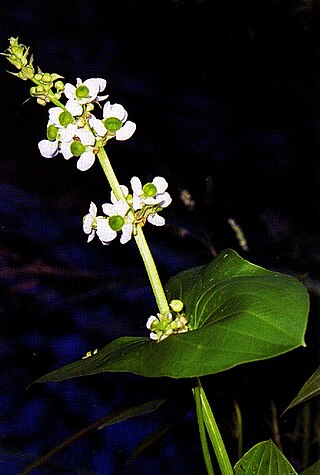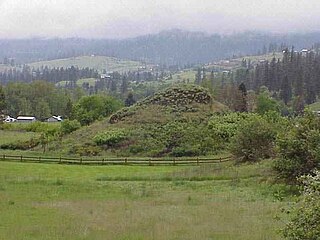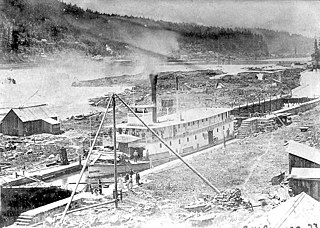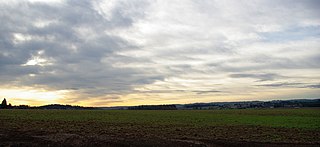Related Research Articles

Tigard is a city in Washington County, Oregon, United States. The population was 54,539 at the 2020 census. As of 2007, Tigard was the state's 12th largest city. Incorporated in 1961, the city is located south of Beaverton and north of Tualatin, and is part of the Portland metropolitan area. Interstate 5 and Oregon Route 217 are the main freeways in the city, with Oregon Route 99W and Oregon Route 210 serving as other major highways. Public transit service is provided by TriMet, via several bus routes and the WES Commuter Rail line.

The Willamette River is a major tributary of the Columbia River, accounting for 12 to 15 percent of the Columbia's flow. The Willamette's main stem is 187 miles (301 km) long, lying entirely in northwestern Oregon in the United States. Flowing northward between the Oregon Coast Range and the Cascade Range, the river and its tributaries form the Willamette Valley, a basin that contains two-thirds of Oregon's population, including the state capital, Salem, and the state's largest city, Portland, which surrounds the Willamette's mouth at the Columbia.

The Yamhill River is an 11-mile (18 km) tributary of the Willamette River, in the U.S. state of Oregon. Formed by the confluence of the South Yamhill River and the North Yamhill River about 3 miles (5 km) east of McMinnville, it drains part of the Northern Oregon Coast Range. The river meanders east past Dayton to join the Willamette River at its river mile (RM) 55 or river kilometer (RK) 89, south of Newberg.
The Siletz were the southernmost of several divisions of the Tillamook people speaking a distinct dialect; the other dialect-divisions were: Salmon River on the Salmon River, Nestucca on Little Nestucca River, Nestucca River and Nestucca Bay, Tillamook Bay on the Tillamook Bay and the mouths of the Kilchis, Wilson, Trask and Tillamook rivers, and Nehalem on Nehalem River. The name "Siletz" comes from the name of the Siletz River on which they live. The origin of the name is unknown

The Treaty with the Kalapuya, etc., also known as the Kalapuya Treaty or the Treaty of Dayton, was an 1855 treaty between the United States and the bands of the Kalapuya tribe, the Molala tribe, the Clackamas, and several others in the Oregon Territory. In it the tribes were forced to cede land in exchange for promised permanent reservation, annuities, supplies, educational, vocational, health services, and protection from ongoing violence from American settlers. The treaty effectively gave over the entirety of the Willamette Valley to the United States and removed indigenous groups who had resided in the area for over 10,000 years. The treaty was signed on January 22, 1855, in Dayton, Oregon, ratified on March 3, 1855, and proclaimed on April 10, 1855.

The Kalapuya are a Native American people, which had eight independent groups speaking three mutually intelligible dialects. The Kalapuya tribes' traditional homelands were the Willamette Valley of present-day western Oregon in the United States, an area bounded by the Cascade Range to the east, the Oregon Coast Range at the west, the Columbia River at the north, to the Calapooya Mountains of the Umpqua River at the south.
Oregon Penutian is a hypothetical language family in the Penutian language phylum comprising languages spoken at one time by several groups of Native Americans in present-day western Oregon and western Washington in the United States. Various languages in the family are divided by dialects that are in most cases identical to the various identified tribal bands in the region.
Central Kalapuyan was a Kalapuyan language indigenous to the central and southern Willamette Valley in Oregon in the United States. It was spoken by various bands of the Kalapuya peoples who inhabited the valley up through the middle of the 19th century. The language is closely related to Northern Kalapuya, spoken in the Tualatin and Yamhill valleys. Dialects of Central Kalapuya that have been identified include:
Yoncalla is an extinct Kalapuyan language once spoken in southwest Oregon in the United States. In the 19th century it was spoken by the Yoncalla band of the Kalapuya people in the Umpqua River valley. It is closely related to Central Kalapuya and Northern Kalapuya, spoken in the Willamette Valley to the north.

The Tualatin Valley is a farming and suburban region southwest of Portland, Oregon. The valley is formed by the meandering Tualatin River, a tributary of the Willamette River at the northwest corner of the Willamette Valley, east of the Northern Oregon Coast Range. Most of the valley is located within Washington County, separated from Portland by the Tualatin Mountains. Communities in the Tualatin Valley include Banks, Forest Grove, Cornelius, Hillsboro, Aloha, Beaverton, Sherwood, Tigard, and Tualatin.

The AtfalatiIPA: [aˈtɸalati], also known as the Tualatin or Wapato Lake Indians are a tribe of the Kalapuya Native Americans who originally inhabited and continue to steward some 24 villages on the Tualatin Plains in the northwest part of the U.S. state of Oregon; the Atfalati also live in the hills around Forest Grove, along Wapato Lake and the north fork of the Yamhill River, and into areas of Southern Portland.

Indigenous peoples of the Northwest Plateau, also referred to by the phrase Indigenous peoples of the Plateau, and historically called the Plateau Indians are indigenous peoples of the Interior of British Columbia, Canada, and the non-coastal regions of the Northwestern United States.

Kalapuyan is a small extinct language family that was spoken in the Willamette Valley of Western Oregon, United States. It consists of three languages.

The Confederated Tribes of the Grand Ronde Community of Oregon (CTGR) consists of twenty-seven Native American tribes with long historical ties to present-day western Oregon between the western boundary of the Oregon Coast and the eastern boundary of the Cascade Range, and the northern boundary of southwestern Washington and the southern boundary of northern California. The community has an 11,288-acre (45.7 km2) Indian reservation, the Grand Ronde Indian Reservation, which was established in 1855 in Yamhill and Polk counties.

Takelma was the language spoken by the Latgawa and Takelma people and Cow Creek band of Upper Umpqua. It was first extensively described by Edward Sapir in his graduate thesis, The Takelma Language of Southwestern Oregon. The last fluent speaker of Takelma, with whom Sapir worked while writing about the language, was Frances Johnson (Gwísgwashãn). A dictionary from English to Takelma is currently being created in the hopes it can be revived.

The Willamette River flows northwards down the Willamette Valley until it meets the Columbia River at a point 101 miles from the Pacific Ocean, in the U.S. state of Oregon.

The Tualatin Plains are a prairie area in central Washington County, Oregon, United States. Located around the Hillsboro and Forest Grove areas, the plains were first inhabited by the Atfalati band of the Kalapuya group of Native Americans. Euro-American settlement began in the 1840s.
The Mohawk or Mohawk River people were a tribe or band of the Kalapuya, who originally lived in the Mohawk River area of present-day Oregon in the United States. They spoke a dialect of the Central Kalapuya language.

The Willamette Valley is a 150-mile (240 km) long valley in Oregon, in the Pacific Northwest region of the United States. The Willamette River flows the entire length of the valley and is surrounded by mountains on three sides: the Cascade Range to the east, the Oregon Coast Range to the west, and the Calapooya Mountains to the south.
The Takelma–Kalapuyan languages are a proposed small language family that comprises the Kalapuyan languages and Takelma, which were formerly spoken in the Willamette Valley and the Rogue Valley in Oregon.
References
- ↑ Jacobs, Melville (1945). Kalapuya Texts. University of Washington Publications in Anthropology. Vol. 11. Seattle: University of Washington.
